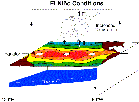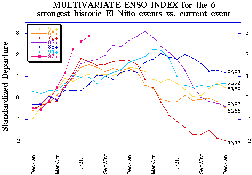ENSO
- Outline:
- The Enso Phenomenon in the Tropics
- Relationship to Mid-Latitude Weather
- Forecasting ENSO
- The ENSO Phenomenon in the Tropics
- On-line Sources of Info
- Coupled atmosphere-ocean interactions in the equatorial Pacific
- Complex interactions between year-to-year fluctuations, the seasonal cycle, and high frequency (intraseasonal-synoptic) fluctuations
- El Nino- Warm Phase:
- anomalously warm SST in the central-eastern equatorial Pacific
- occurs every 2-7 years
- Big events: 1957-58; 1966; 1973; 1982-83 (biggest to date); 1987;
1991-95 (hyper El Nino); 1997

- weakening of trade winds along equator
- enhanced convection in central equatorial Pacific; diminished
precipitation over maritime continent


- La Nina- Cool Phase:
- anomalously cool SST in the central-eastern equatorial Pacific
- occurs every 2-7 years
- Big Events: 1955; 1971; 1974; 1976; 1989;1999
- strengthening of trade winds along equator
- diminshed convection in central equatorial Pacific; enhanced
precipitation over maritime continent
- Comparison of 97 and Earlier Events
- Relationship to Mid-Latitude Weather
- ENSO affects mid-latitudes indirectly
- ENSO causes adjustments to the planetary scale circulation;
affects the position of the subtropical and
polar jets
- Dynamically, this adjustment can be explained in terms of:
- response to anomalous distribution of diabatic heating
- enhanced convection in central-eastern equatorial Pacific
- diminished convection over maritime continent
- direct impacts onto equatorial and subtropical circulation
- anomalous upper tropospheric easterlies near the equator in the vicinity ofthe excessive diabatic heating
- anomalously strong westerlies to the north of an accentuated subtropical circulation
- dispersion
of energy away from anomalous energy source regions near equator
-
excessive
diabatic heating in the central equatorial Pacific and the diminshed
diabatic heating over the maritime continent
- stationary response to changes in diabatic heating requires energy to
be propagated away from source region
- for energy to propagate from equator requires westerly flow aloft, which
is not usually present near equator
during NH winter
- dispersion of energy away from anomalous energy source regions in subtropics
- adjustment of mass-wind fields in subtropics as a result of diabatic heating anomalies near equator
- general circulation models capable of reproducing many aspects of response of mid-latitude circulation to anomalous diabatic heating in tropics
- considerable sensitivity of response in mid-latitudes to:
- seasonal cycle; timing of onset and demise of event
- biggest mid-latitude response in late winter (January-March)
- smallest reponse during mid-latitude summer (July-August)
- interactions with in-situ mid-latitude climate variations due to other sources (e.g., non-linear dynamical interactions, snow-ice variations)
- Composite Patterns
- Climate Anomalies: 1979-1995
- Seasonal Climate Extreme Risks
Forecasting ENSO
- Simplified Models & Statistical Methods
- GCMs
- Atmospheric GCMs forced by forecast SST or output directly from coupled atmosphere-ocean GCMs are beginning to show some skill at predicting monthly and seasonal anomalies 1-2 periods in advance



